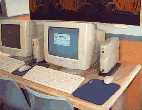Useful Links: www.tomw.net.au/links
IT issues on 666 ABC Canberra Drive with Keri Phillips each Wednesday at 5:50pm
 With Tom Worthington FACS, Visiting Fellow,
Department of Computer Science, Australian National University
With Tom Worthington FACS, Visiting Fellow,
Department of Computer Science, Australian National University
Thin Clients at School, 5 June 2002
On Tuesday 4 June 2002, Palmerston District Primary School celebrated the installation of a new Palmerston District Primary School have installed a new "Thin Client" computer system. A few years ago this technology was the preserve of large corporate and government systems, such as classified military systems at the Australian Defence Department, but are now affordable for small business and educational use. Australia was once a world leader in thin client technology.
What is a Thin Client?
Q.) What does the term Thin Client mean?
A.) In the computing sense it means the normal desktop (PC/Mac) that sits on a clients desktop, does not have much in the way of processing power, disk space or memory. All of the processing (eg Word/Excel/Netscape) is performed on a central server, rather than on the clients PC. On the desktop, appears an NT desktop window, but the difference between this and a normal NT (IBM PC in our case) PC, is that the processing, and saving of files is not happening locally. Clients use a Graphical User Interface (GUI) to interact with the server, unlike the Terminal Servers of yester-year.
...
Q.) Where are my files stored?
A.) Files are stored on the central file server, rather than on your local PC/MAC hard drive. These files are archived regularly, and are automatically mirrored, so there is always a duplicate copy. This is much more than you would tend to do on your own PC/MAC.
Q.) Why aren't they stored on my computer?
A.) It may come as a surprise, but one of the major costs of buying a computer is support costs. To purchase a computer costs about $2,500, but the support costs for the lifespan of the computer is about $8,400 ($2,800 per year). So the total cost to the University can be as high as $11,000 (this doesn't take into account downtime costs, absorbed by the client). By storing files on your PC/Mac, less time is spent trying to recover these files, or general 'fiddling' about to get it working again when it failure. Failures of machines running solely thin client software, can be replaced readily, by another computer, irregardless of age or speed (of the computer that is).
From Commonly Asked Questions about Thin Client Computing, Charles Sturt University (last updated 5 March 1999)
At the School
Palmerston District Primary School opened in 1995 and currently has 464 students. The aim is to have one computer per 2 students. Teachers use Personal Computers (PCs) for access to administration system and students use Thin Clients on a student network. There are a total of 200 desktop units currently (100 PCs and 100 thin clients). The school is connected to the Canberra Schools Network and Intranet. Microsoft software is used via a Server based, Thin Client system from DyCom Business Systems.
Hardware:
100 NCD Thin Clients and LG multimedia monitors with integrated speakers.
3 IBM application servers
FISC CD Cache
IBM Domain controller / File server
UPS
The thin clients are expected to last 6 years, with upgrades needed to the servers in about 3 years. Sixteen old PCs were recycled by adding client software. The servers run Windows 2000 Advanced Server and Terminal Services. The teachers and administrators PCs are on a separate network for security. Each PC can access the student network, with a firewall to keep the students out of the administrative system.
Students use popular software, including Microsoft Office Suite, Encarta, Paint Shop Pro, FrontPage and IE. The library catalogue can be checked from any desktop.
- Keyboard, screen and thin client processor
- Thin client processor, close up of front
- Thin client processor, close up of back
Thin Client at the ANU
The Department of Computer Science at the Australian National University has about 100 Sun Ray thin client workstations for student use.
Thin Client at the ANU
The ANU has approximately 150 SunRay thin client workstatiosn for use by computer science students.
An Australian Industry Opportunity Missed
Labtam, based in Melbourne, produced advanced thin client workstations (then called "X terminals") in 1989. These were sold to organisations such as the Austral;ian Department of Defence and ANU. However, it was difficult for Labtam to convince Australian buyers that an Australian product could be so good and at that stage ordinary office automation products did not run on the terminals. The X-terminal hardware business was sold to Tektronix Inc., but Labtam Inc. but still sell software.
Further Information:
- More links
- 666 ABC Canberra Drive with Keri Phillips
- Author's home page
Comments and corrections to: webmaster@tomw.net.au
Copyright © Tom Worthington 2001-2002.
 1
1 2
2 3
3